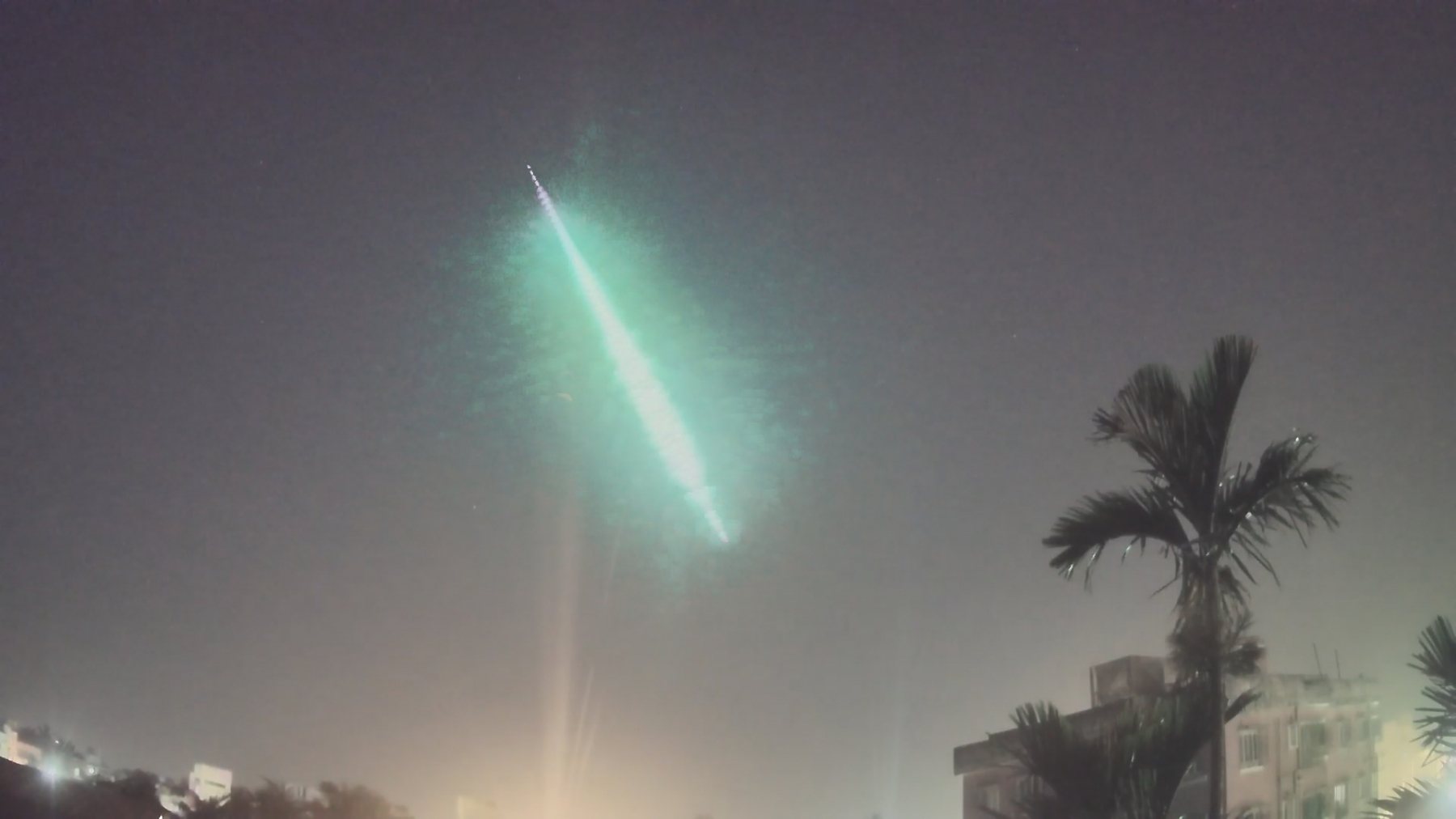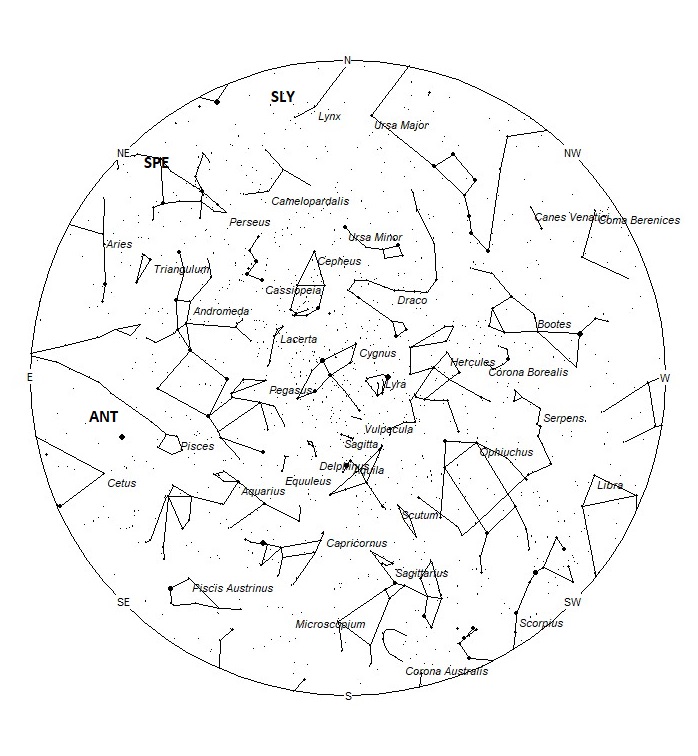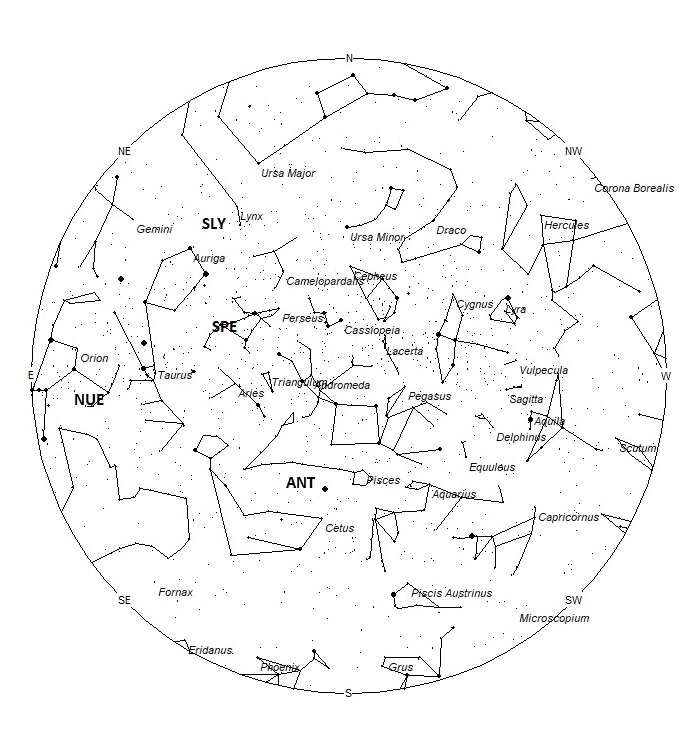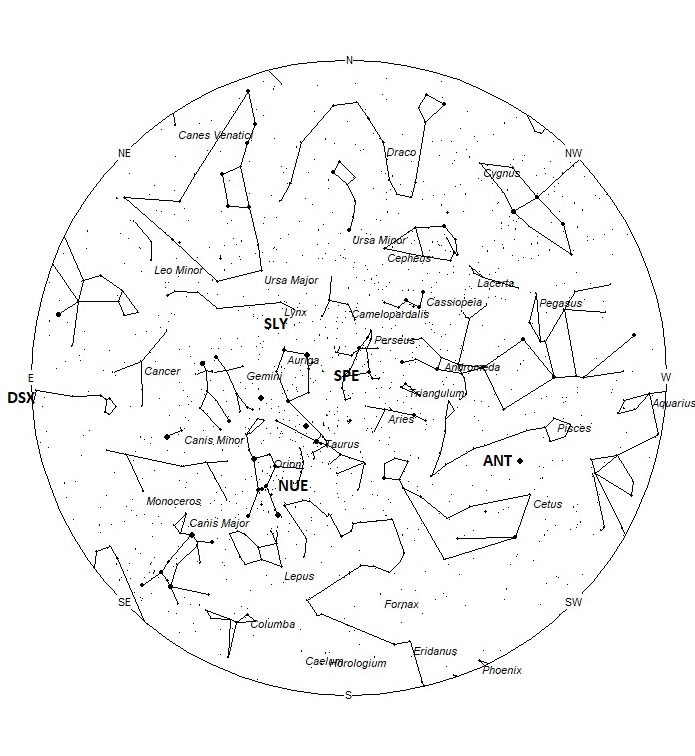 Ranjit Biswas captured this brilliant fireball at 19:43 UT on March 13th 2022 (01:13 IST on March 14th), from Kolkata, West Bengal, India. Many thanks for allowing us to share this event with our readers. ©Ranjit Biswas
Ranjit Biswas captured this brilliant fireball at 19:43 UT on March 13th 2022 (01:13 IST on March 14th), from Kolkata, West Bengal, India. Many thanks for allowing us to share this event with our readers. ©Ranjit BiswasDuring this period, the moon reaches its last quarter phase on Saturday September 17th. At that time the moon will lie 90 degrees west of the sun and will rise between 2300 and midnight. As the week progresses the waning crescent moon will rise later in the morning, providing a longer window of dark skies with each passing night. The estimated total hourly rates for evening observers this week should be near 4 as seen from mid-northern latitudes (45N) and 3 as seen from tropical southern locations (25S) For morning observers, the estimated total hourly rates should be near 10 as seen from mid-northern latitudes (45N) and 6 as seen from tropical southern locations (25S). Morning rates are reduced due to interfering moonlight. The actual rates will also depend on factors such as personal light and motion perception, local weather conditions, alertness, and experience in watching meteor activity. Note that the hourly rates listed below are estimates as viewed from dark sky sites away from urban light sources. Observers viewing from urban areas will see less activity as only the brighter meteors will be visible from such locations.
The radiant (the area of the sky where meteors appear to shoot from) positions and rates listed below are exact for Saturday night/Sunday morning September 17/18. These positions do not change greatly day to day so the listed coordinates may be used during this entire period. Most star atlases (available at science stores and planetariums) will provide maps with grid lines of the celestial coordinates so that you may find out exactly where these positions are located in the sky. I have also included charts of the sky that display the radiant positions for evening, midnight, and morning. The center of each chart is the sky directly overhead at the appropriate hour. These charts are oriented for facing south but can be used for any direction by rotating the charts to the desired direction. A planisphere or computer planetarium program is also useful in showing the sky at any time of night on any date of the year. Activity from each radiant is best seen when it is positioned highest in the sky, either due north or south along the meridian, depending on your latitude. It must be remembered that meteor activity is rarely seen at the radiant position. Rather they shoot outwards from the radiant, so it is best to center your field of view so that the radiant lies at the edge and not the center. Viewing there will allow you to easily trace the path of each meteor back to the radiant (if it is a shower member) or in another direction if it is sporadic. Meteor activity is not seen from radiants that are located far below the horizon. The positions below are listed in a west to east manner in order of right ascension (celestial longitude). The positions listed first are located further west therefore are accessible earlier in the night while those listed further down the list rise later in the night.
These sources of meteoric activity are expected to be active this week.
.
The large Anthelion (ANT) radiant is currently centered at 00:28 (007) +03. This position lies in southern Pisces, 4 degrees northeast of the brilliant planet Jupiter. Rates at this time should be near 2 per hour no matter your location. Observers concentrating on this activity should face half-way up in the northern sky near 01:00 LST to best view these meteors. With an entry velocity of 30 km/sec., the average Anthelion meteor would be of medium-slow velocity.
The September epsilon Perseids (SPE) are active from September 2-23, with maximum activity occurring on the 10th. The current position of the radiant lies at 03:48 (057) +40. This area of the sky lies in southern Perseus, 2 degrees west of the 3rd magnitude star known as epsilon Persei A. To best see these meteors, face half-way up toward the north during the last hour prior to dawn. Rates at this time should less than 1 per hour no matter your location. There have been outbursts from this source in the past, but none are predicted for this year. With an entry velocity of 65 km/sec., the average meteor would be of swift velocity.
The last of the nu Eridanids (NUE) are expected this week. Activity from this source stretches from August 31 to September 21. The main maximum activity occurs on September 11th. A secondary maximum occurs on September 17th. The radiant currently lies at 04:56 (074) +03, which places it in western Orion, just northeast of the 4th magnitude star known as pi5 Orionis. Observers concentrating on this activity should face half-way up in the eastern sky during the last dark hour prior to dawn to best view these meteors. Current rates are expected to be near 1 per hour this weekend this period no matter your location. With an entry velocity of 66 km/sec., the average meteor from this source would be of swift velocity.
The September Lyncids (SLY) are composed of two weak showers active throughout September. The later branch is active from September 16th through October 3rd maximum activity occurring on September 28th. The radiant is located at 06:40 (100) +50, This position lies on the Auriga/Lynx border, 8 degrees northeast of the 2nd magnitude star known as Menkalinan (beta Aurigae). To best see these meteors, view half-way up in the northeastern sky during the last hour prior to dawn. Rates are expected to be less than 1 per hour. With an entry velocity of 59 km/sec., the average meteor from this source would be of swift velocity.
The Daytime Sextantids (DSX) are active from September 22-October 13, with maximum activity occurring on October 3. The current position of the radiant is 09:28 (142) +01. This position lies in western Hydra, 3 degrees southeast of the 4th magnitude star known as theta Hydrae. This radiant is best placed during the last hour prior to dawn, when it lies highest in a dark sky. Rates at this time should be less than 1 per hour no matter your location. With an entry velocity of 34 km/sec., the average DSX meteor would be of medium-slow velocity. No matter your location, these meteors are difficult to observe as the radiant lies roughly 30 degrees from the sun. Therefore, these meteors may only be seen during the last hour prior to dawn, shooting upward from the eastern horizon.
Sporadic meteors are those meteors that cannot be associated with any known meteor shower. All meteor showers are evolving and disperse over time to the point where they are no longer recognizable. Away from the peaks of the major annual showers, these sporadic meteors make up the bulk of the activity seen each night. As seen from the mid-Northern Hemisphere (45N) one would expect to see during this period approximately 8 sporadic meteors per hour during the last hour before dawn as seen from rural observing sites. Evening rates would be near 3 per hour. As seen from the tropical Southern latitudes (25S), morning rates would be near 4 per hour as seen from rural observing sites and 2 per hour during the evening hours. Locations between these two extremes would see activity between these listed figures. Moonlight reduces the number seen during the morning hours.
You can keep track of the activity of these meteor showers as well as those beyond the limits of visual observing by visiting the NASA Meteor Shower Portal available at: https://meteorshowers.seti.org/ You can move the sky globe to see different areas of the sky. Colored dots indicate shower meteors while white dots indicate sporadic (random) activity. The large orange disk indicates the position of the sun so little activity will be seen in that area of the sky.
The list below offers the information in tabular form of the showers that I feel are within reach of the visual observer to discern. Hourly rates are often less than 1 but noting parameters such as the radiant distance and the elevation, one can compute the probably of shower association. Most showers discovered by video means have rates less than 1 per night away from maximum, so these listed showers are not as weak as they seem. Rates and positions are exact for Saturday night/Sunday morning except where noted in the shower descriptions.
| SHOWER | DATE OF MAXIMUM ACTIVITY | CELESTIAL POSITION | ENTRY VELOCITY | CULMINATION | HOURLY RATE | CLASS |
| RA (RA in Deg.) DEC | Km/Sec | Local Daylight Saving Time | North-South | |||
| Anthelion (ANT) | – | 00:28 (007) +03 | 30 | 02:00 | 2 – 2 | II |
| September epsilon Perseids (SPE) | Sep 10 | 03:48 (057) +40 | 65 | 05:00 | <1 – <1 | II |
| nu Eridanids (NUE) | Sep 11 | 04:56 (074) +03 | 66 | 06:00 | <1 – <1 | IV |
| September Lyncids (SLY) | Sep 28 | 06:40 (100) +50 | 59 | 09:00 | <1 – <1 | IV |
| Daytime Sextantids (DSX) | Oct 03 | 09:28 (142) +01 | 34 | 12:00 | <1 – <1 | IV |
Class Explanation: A scale to group meteor showers by their intensity:
- Class I: the strongest annual showers with Zenith Hourly Rates’s normally ten or better.
- Class II: reliable minor showers with ZHR’s normally two to ten.
- Class III: showers that do not provide annual activity. These showers are rarely active yet have the potential to produce a major display on occasion.
- Class IV: weak minor showers with ZHR’s rarely exceeding two. The study of these showers is best left to experienced observers who use plotting and angular velocity estimates to determine shower association. These weak showers are also good targets for video and photographic work. Observers with less experience are urged to limit their shower associations to showers with a rating of I to III.
 American Meteor Society
American Meteor Society



I saw a shooting star in Merrifield, Virginia tonight (September 21, 2022) at approximately 8:30 p.m. It looked closer than it probably was, and at first I thought it was a firework. I’m pretty sure it wasn’t a firework because it had a solo sparkly trail, was wider than a firework and didn’t last as long as a firework trail would have lasted.
I just saw a bright green streak in the sky, 23 September, 8:26 am at Canmore, Alberta, Canada. It had a long trail but the sighting lasted not longer than a second. There was another man who also witnessed that around me. It was a pleasant surprise, I did not know we could see these during the day too.
Just saw a fireball over Monroe Mi. It was Blue on the outside and White in the center.6:00ish am Tuesday 11/8/22